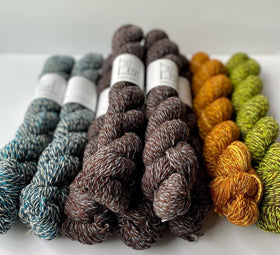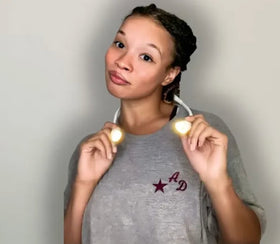
Lori Versaci knitwear designer
..

In the fall of 2015 Lori Versaci taught a class at String Theory. She changed the way I thought about swatching forever. We've been in contact ever since and someday I'll convince her to make the trip again. Until then, I'm grateful that she agreed to answer a few questions.

behind the scenes photo shoot
What motivated you to start designing?
In some ways I have been designing knitwear since I was a teenager. When I was 14, I took a carpool to school every morning with 4 other girls. For Christmas that year, I knit a pair of mittens for each person in my carpool. I had an old pattern from my mother, but I customized each pair — one had cables up the front, one had a Christmas Tree motif, etc. So, pretty much from the time I started knitting, I considered a pattern to be a “suggestion” or “guideline”. I very rarely knit a pattern as written.
But my career in knitwear design didn’t begin until 40 some years later. I found it very hard to knit when my kids were little. Not that I didn’t have projects going, but I really didn’t have the time to work on them in a concerted way except on vacation. I worked full time and travelled quite a bit and had the kids, so… But when one of my nannies had a baby, I picked up knitting again with a vengeance! And I found myself creating my own designs.
Fast forward a few years later, when my life became even more complicated and I found that my full time job was not only interfering with my newfound love for design, but also with the stresses of older children and aging parents. So, the time seemed right to give this new career idea, which gave me increased time flexibility, a chance. It is interesting to note that this second career is no less challenging or time consuming than my first, just very different!

New sweater in Woolfolk Flette - coming soon!
What is your favorite part of the creative process?
I love this question so much because few people really think of knitwear design as being a “process” to begin with!
My favorite part is, and always will be, the knitting! No matter how sure I am at the beginning of how a design will unfold, once I have the yarn on the needles, things change. And this is very exciting for me. I truly believe that the difference between a really great pattern and an adequate one is in the details. And I love to obsess over things like “should that decrease be a ssk or a k2tog” or “how many sts from the edge should that shaping occur”. I think these details are particularly important to me because I want to really be able to wear what I make, so I want it to be as polished as possible.
What is your favorite knitting tip?
Don’t get stuck using tools that are marketed or designed for knitters. Some of my favorite knitting tools were never designed for knitters but are practical and inexpensive:
I use a 4”x4” lucite quilting ruler for counting my gauge. I love them because you can see through them, making them easy to place on your fabric, the edges are very straight, making it easy to count the sts or rows and they are inexpensive! (We have these at String Theory.)
I use loom bracelet bands for marking the rows when I am making increase or decrease to to mark the row where I started my underarms, etc. They come in many colors, so I can keep track of how many decreases I have made every 4 rows and then use a new color to mark my decreases every 6 rows. I can even count out my bands at the beginning so that I don’t have to keep referring back to the pattern! And then, you can just cut them out before blocking. Or, leave in the key measurement ones when you block… (We have these at String Theory.)
And my latest find is using hollow plastic string (gimp that we used for making lanyards at summer camp) for slipping live stitches onto so that you can try something on when you are knitting or block it while in process. This idea came from Anna Maltz (Sweater Spotter) and is a knitters dream come true!! (We have these at String Theory.)

Newly released Gridlock in Woolfolk Tynd
Any recommendation for what to watch or listen to while we knit?
I am a rabid Audible listener. I am dyslexic, so reading has always been a challenge or me. Books on tape are a complete game changer for me. There are so many books that I just couldn’t really read and enjoy because it was so much work for me. So now I listen and listen and listen. The joy for me is that I now spend a lot of time talking to my sister and friends about books we are or have read! Something that I really never did before.

How do your values impact your business?
Since Janet spends so much effort on ensuring that her business reflects her values, I feel compelled to really give this question some thought.
My first thought gets back to my belief that every pattern that I sell needs to provide value to its user. I know that there are a lot of people who think that knitting patterns are expensive or that they should be included for free when you buy yarn. And I always want to respond with the whole story of how much effort and expense (particularly time, which is not compensated for directly) goes into producing a pattern. Instead, I try to make sure that each pattern that I publish is well written, appropriately edited and tested and that the photographs used represent what can be expected.
My second thought is about the yarns, yarn companies and independent dyers that I choose to work with. While initially, when I was trying to establish my own brand, I worked a lot with yarn companies whose yarns I loved and who could help me build awareness of my work. But as I have become more established, I have worked with more and more independent producers and dyers whose work I admire and who I hope I can help promote. So I am hoping in my own little way that I am able to give back or pay it forward a bit, while also making choices about where and how the yarn I use is sourced and dyed.
Finally, wherever I can, I work to help other, often newer designers in whatever way I can. I am happy to say that, for the most part, the designer community is very giving and supportive. So often, we are working alone and there are no structured ways for us to interact, no associations or training organizations. This is especially true when new designers are starting out. So, I always try to share freely what I have learned, mistakes that I have made and things that I have learned.




Leave a comment